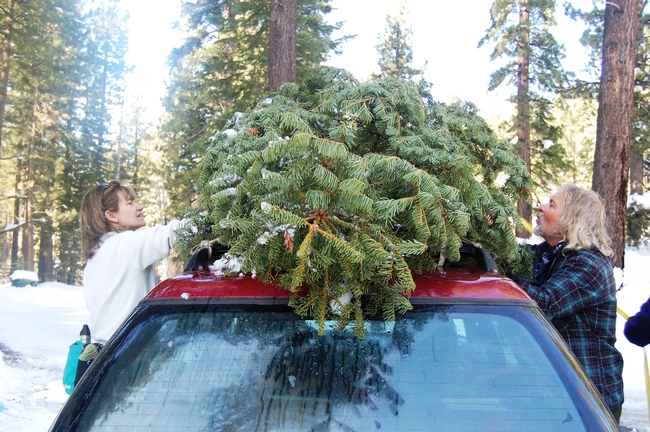
Every year, the day after Thanksgiving, Susie Kocher bundles up her children, gathers the extended family and hikes into the Lake Tahoe Basin forest to find a Christmas tree.
“It’s my favorite part of the season,” Kocher said. “Having the fresh, living thing in the house really symbolizes the holiday. You can’t do it with a fake tree.”
Kocher, a forester and the natural resources advisor for UC Cooperative Extension in the Central Sierra, lives and works in Lake Tahoe. The Lake Tahoe Basin Management District is one of nine national forests in California, all of them in the northern part of the state, where the U.S. Forest Service allows Christmas tree cutting with a $10 permit.
Though some people mourn the death of any tree, Kocher says careful selection and removal of Christmas trees is an enchanting family tradition that enriches forest health.
“We have a lot of small trees on public lands because of fire suppression,” Kocher said. “They’re all competing with one another and many will ultimately die. A smart harvest of Christmas trees can improve the forest by helping with thinning.”
People with permits to cut down Christmas trees in national forests must follow strict guidelines. The trees must be within 10 feet of another living tree, the base of the trunk cannot be more than six inches wide and it must be cut within six inches of the ground. Some national forests limit the harvest to certain tree species.
Despite committing to these guidelines when obtaining a permit, Kocher said she has seen some Christmas tree harvesters make ill-advised choices.
“Some are too lazy to find a good tree and will cut the top off a large tree,” Kocher said. “You can be driving around and see what looks like a poor old Dr. Suess tree, which is what grows from the ugly remnant left behind in the forest.”
Such irresponsible Christmas tree cutting has led some forests to discontinue Christmas tree harvesting for personal use.
Kelly Hooten, information specialist with the Sierra National Forest, said the organization stopped issuing Christmas tree cutting permits because people would tend to cut down only healthy, strong trees.
“It’s really the sickly, Charlie Brown trees that we would prefer to thin in our forest,” Hooten said.
The El Dorado National Forest does not allow Christmas tree cutting because there are more than 30 Christmas tree farms in the vicinity where visitors can choose and cut down their own trees.
“Allowing Christmas tree cutting in forests would hurt these farmers economically,” said Lynn Wunderlich, UCCE advisor in the Central Sierra office. Many Christmas tree farmers also provide food, crafts, activities and visits with Santa.
“Families can visit the farmer year after year as their children grow, so that’s part of the experience,” Wunderlich said.
There has been ongoing debate about whether a fake tree or real tree is more environmentally friendly, but for Kocher, there is no question.
“Fresh real trees are a renewable resource, fake trees are not,” she said. “It’s an agricultural product. You can contribute to a local farmers’ income or you can help thin the forest. Picking and bringing home a fresh tree, decorating it and smelling it defines the season for me. Without it, I don’t think it would feel like Christmas.”